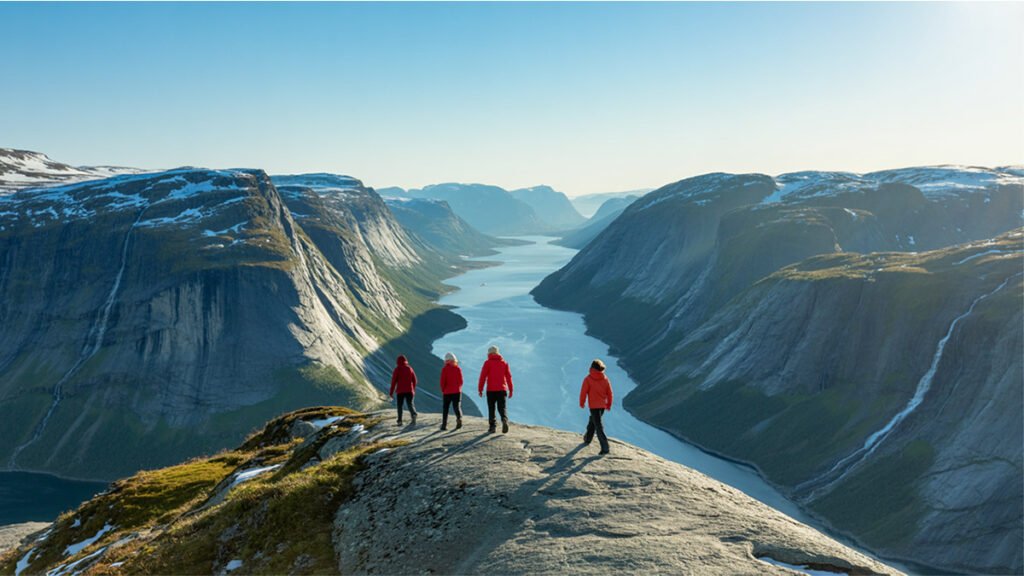Estimated reading time: 14 minutes
Key Takeaways
- Norway offers some of the world’s most spectacular hiking trails including Trolltunga, Preikestolen, and Besseggen Ridge
- The best hiking season in Norway is from late June to early September when trails are most accessible and weather conditions are favorable
- Norway’s national parks like Jotunheimen and Rondane provide diverse landscapes and well-maintained trails for hikers of all levels
- Stunning waterfalls such as Seven Sisters and Vøringsfossen are must-visit natural attractions, best viewed during spring thaw
- Scenic drives through routes like the Atlantic Road and Trollstigen complement hiking adventures, offering access to remote trailheads
- Proper preparation is essential – pack appropriate hiking gear, check weather forecasts, and follow safety guidelines for a successful adventure
Table of Contents
- Introduction
- Norway’s Iconic Hiking Trails
- Must-See Waterfalls in Norway
- Discovering Norway National Parks
- Scenic Drives in Norway
- Embracing Outdoor Adventures in Norway
- Frequently Asked Questions about Hiking in Norway
Introduction
Hiking in Norway opens the door to unforgettable outdoor adventures amidst some of the world’s most stunning natural backdrops. This Nordic wonderland offers travelers a perfect blend of towering fjords, majestic waterfalls, lush forests, and pristine landscapes that few other destinations can match. From iconic rock formations made famous on social media to hidden trails known only to locals, Norway’s terrain offers adventures for both beginners and seasoned trekkers. This guide is designed to help you plan the ultimate hiking trip in Norway.
What makes Norway truly special is how its natural wonders are complemented by excellent infrastructure. Well-maintained trails, helpful signage, and a network of mountain cabins make even remote areas accessible to visitors. Whether you’re planning a challenging multi-day trek or seeking family-friendly day hikes, this guide provides both practical information and insider tips to help you plan your Norwegian hiking adventure with confidence.
Want to see this for yourself? Click here to watch the video from this point.
Norway’s Iconic Hiking Trails
Norway boasts some of the most spectacular hiking trails in the world, with routes that showcase the country’s dramatic landscapes and natural beauty. The best hikes in Norway range from easy day trips to challenging multi-day treks, each offering a unique perspective on this Nordic paradise. Top trails include Trolltunga, Preikestolen, and the famous Besseggen Ridge.
Trolltunga: The Troll’s Tongue
Trolltunga stands as perhaps Norway’s most photographed natural landmark – a dramatic rock formation jutting horizontally out from a mountain, suspended 700 meters above Lake Ringedalsvatnet. This challenging hike requires good fitness and preparation:
- Distance: 28 km round trip (approximately 10-12 hours)
- Difficulty: Challenging
- Best Season: Summer months (June–September) when the trail is free from snow and daylight hours are long [SOURCE]
- Notable Feature: The iconic rock platform offering panoramic views of mountains and lakes
Outside the summer season, guided hikes are strongly recommended due to challenging weather conditions and shorter daylight hours. The spectacular view of standing on the edge of Trolltunga makes the strenuous journey worthwhile for thousands of hikers annually.
For a full guide to planning the Trolltunga hike, see our detailed Odda route guide.
Top Picked Activities for Trolltunga
Preikestolen (Pulpit Rock)
More accessible than Trolltunga but equally breathtaking, Preikestolen is a flat mountain plateau that towers 604 meters above the Lysefjord:
- Distance: 8 km round trip (approximately 4-5 hours)
- Difficulty: Moderate
- Best Time: Late spring to early autumn [SOURCE]
- Notable Feature: The massive cliff face offering dramatic views over Lysefjord
This hike is more manageable for casual hikers while still delivering an unforgettable experience. For the best photographs and fewer crowds, consider hiking early in the morning or late afternoon. The relatively short distance makes Pulpit Rock accessible for day trips from nearby Stavanger.
Top Picked Activities for Pulpit Rock
Besseggen Ridge
Located in Jotunheimen National Park, the Besseggen Ridge hike is famous for its narrow passage between two contrasting lakes – the deep blue Gjende and the emerald green Bessvatnet:
- Distance: 14 km one-way (typically 6-8 hours)
- Difficulty: Challenging
- Best Time: July to September
- Notable Feature: The dramatic ridge walk with lakes of different colors on either side [SOURCE]
Most hikers take the Gjende boat to Memurubu and hike back to Gjendesheim, creating a more manageable one-way journey. The ridge itself requires some scrambling and a head for heights, but the views are simply spectacular.
Romsdalseggen Ridge
Often cited as one of Norway’s most beautiful hikes, Romsdalseggen Ridge offers panoramic views of the Romsdalen Valley, the Trollveggen (Troll Wall), and surrounding peaks:
- Distance: 10-11 km (approximately 6-8 hours)
- Difficulty: Moderate to challenging
- Best Time: July to September
- Notable Feature: Breathtaking views of Norway’s highest vertical rock face [SOURCE]
These ridges are among the most rewarding trekking routes in Norway, attracting hikers from around the globe. The trail offers constantly changing vistas and varied terrain throughout the hike. A shuttle bus service operates from Åndalsnes to the trailhead during the summer season, making this spectacular hike easily accessible.
Essential Hiking Tips for Norway
Before setting out on any Norwegian hiking adventure, keep these important considerations in mind:
- Trail difficulty varies significantly – be honest about your fitness level and choose appropriate routes. What might be described as “moderate” in Norway could be quite challenging for those used to gentler terrain.
- Optimal hiking seasons are generally from late June to early September when trails are snow-free and conditions are safest. Mountain weather can be unpredictable even in summer.
- Essential gear includes waterproof hiking boots with ankle support, layered clothing (preferably wool), waterproof outer layers, a map/compass or GPS, sufficient food and water, and a first aid kit [SOURCE].
- Weather checks are crucial – always check current conditions before starting your hike. Weather can change rapidly in mountainous regions [SOURCE].
- Leave No Trace principles should be followed to preserve Norway’s pristine natural environment. Pack out all trash and stay on marked trails.
By respecting the wilderness and coming prepared, you’ll experience the true majesty of Norway’s spectacular landscapes in a safe and sustainable way.
Must-See Waterfalls in Norway
Norway’s dramatic topography creates the perfect conditions for spectacular waterfalls, many of which rank among the world’s most impressive. These waterfalls are highlights of many hiking routes in Norway, often serving as either main destinations or rewarding features along the trail.
Norway Waterfalls to Visit
Among the hundreds of waterfalls that dot the Norwegian landscape, several stand out for their beauty, accessibility, and sheer power:
Seven Sisters (De Syv Søstre)
Located along the Geirangerfjord, the Seven Sisters waterfall is one of Norway’s most iconic natural attractions:

- Height: The tallest of the seven parallel falls drops about 250 meters
- Best Viewing: From a boat tour on the fjord
- Peak Season: Late spring (May-June) when snowmelt maximizes water flow [SOURCE]
- Local Legend: According to folklore, the Seven Sisters dance across from the Suitor waterfall, which never manages to meet them
For photographers, morning light often creates rainbows in the mist, making for spectacular images. Boat tours on the Geirangerfjord provide the best vantage points, as the falls cascade directly into the fjord waters.
Vøringsfossen
One of Norway’s most famous and powerful waterfalls, Vøringsfossen offers a spectacular display of nature’s force:

- Height: 182 meters total drop, with a free fall of 145 meters
- Location: Near Hardangervidda National Park in western Norway
- Viewing Options: Several platforms, including a newly built bridge and viewing area
- Accessibility: Easily reached by car from the nearby tourist route
Recent infrastructure improvements have made this waterfall even more accessible, with striking architectural viewing platforms that enhance the experience while protecting visitors and the natural environment.
Langfossen
Often overlooked by international tourists, Langfossen in Åkrafjord is considered by many Norwegians to be among the country’s most beautiful waterfalls:
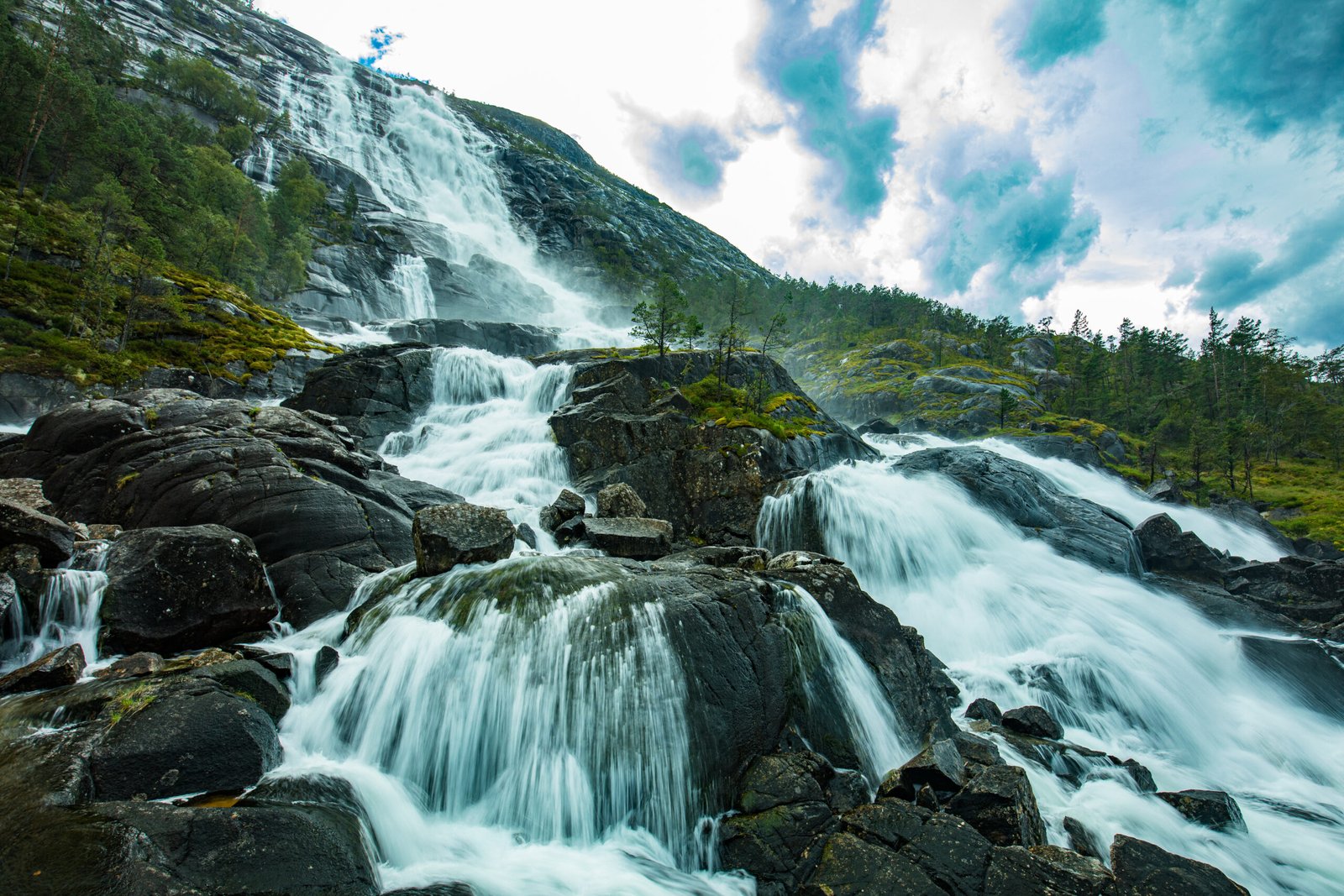
- Height: 612 meters
- Unique Feature: Cascades directly into the fjord without being broken
- Viewing: Visible from the E134 highway or by boat on the fjord
CNN once named Langfossen one of the world’s ten most beautiful waterfalls, and its uninterrupted flow from mountain to fjord creates a truly mesmerizing sight.
Steinsdalsfossen
What makes Steinsdalsfossen special is not just its beauty but the experience it offers visitors:
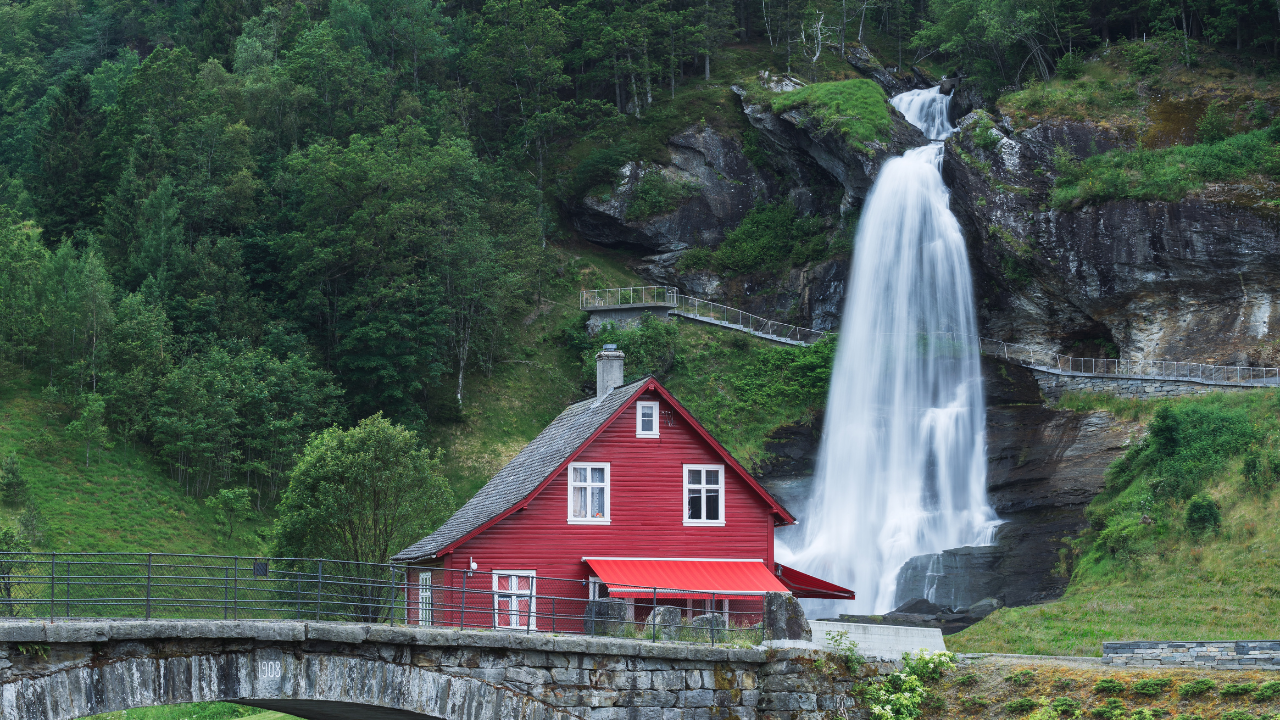
- Height: 50 meters
- Unique Experience: A path allows visitors to walk behind the waterfall without getting wet
- Location: Near Norheimsund, about 1.5 hours from Bergen
This waterfall demonstrates how Norway has made its natural wonders accessible while preserving their beauty, allowing visitors to experience the power of falling water from a unique perspective.
Best Times and Tips for Waterfall Viewing
To make the most of your waterfall experiences in Norway:
- Timing is crucial – Visit during the spring thaw (May to early June) when snowmelt creates the most dramatic flows
- Consider boat tours for waterfalls that cascade directly into fjords for unique perspectives
- Bring a waterproof camera case – The mist from larger falls can soak equipment
- Morning light often creates rainbows in the waterfall mist, perfect for photography
- Some falls are illuminated at night during summer months, offering a different spectacular view
Norway’s waterfalls are not merely scenic features but powerful reminders of the country’s wild natural forces that have shaped its landscapes over millennia. Whether you’re an avid hiker or prefer more accessible viewing points, these cascading wonders should be high on your list when planning your Norwegian adventure.
Explore more on waterfalls like the Seven Sisters in our Best Fjord Tours guide.
Discovering Norway National Parks
Norway national parks represent the country’s commitment to preserving its natural heritage, offering visitors pristine wilderness experiences across diverse landscapes. From mountain plateaus and glaciers to coastal environments, these protected areas provide some of the best hiking opportunities in Scandinavia.
Jotunheimen National Park: Home of Giants
Jotunheimen, whose name translates to “Home of the Giants,” lives up to its epic title as Norway’s premier mountain destination. Jotunheimen offers some of the best hikes in Scandinavia:
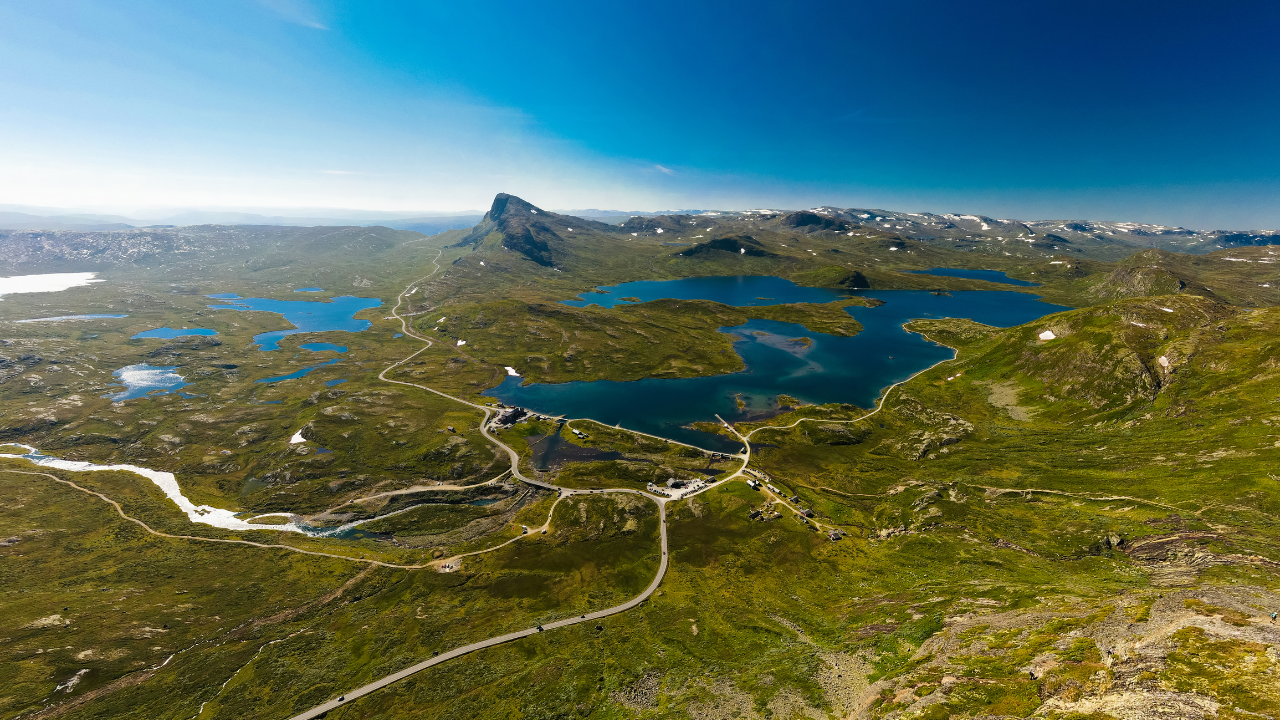
- Size: 1,151 square kilometers
- Key Features: Contains 29 of Norway’s highest peaks, including Galdhøpiggen (2,469m), Northern Europe’s highest mountain
- Iconic Hikes: Besseggen Ridge, Galdhøpiggen summit, and the Hurrungane range [SOURCE]
- Wildlife: Home to wild reindeer, wolverines, lynx, and numerous bird species
The park features a vast network of marked trails and staffed mountain lodges run by the Norwegian Trekking Association (DNT). This makes multi-day hikes possible even for those who prefer not to camp. The variety of terrain caters to all skill levels, from family-friendly day walks to technical mountaineering routes.
Rondane National Park: Norway’s Oldest
Established in 1962 as Norway’s first national park, Rondane offers a more accessible mountain experience:
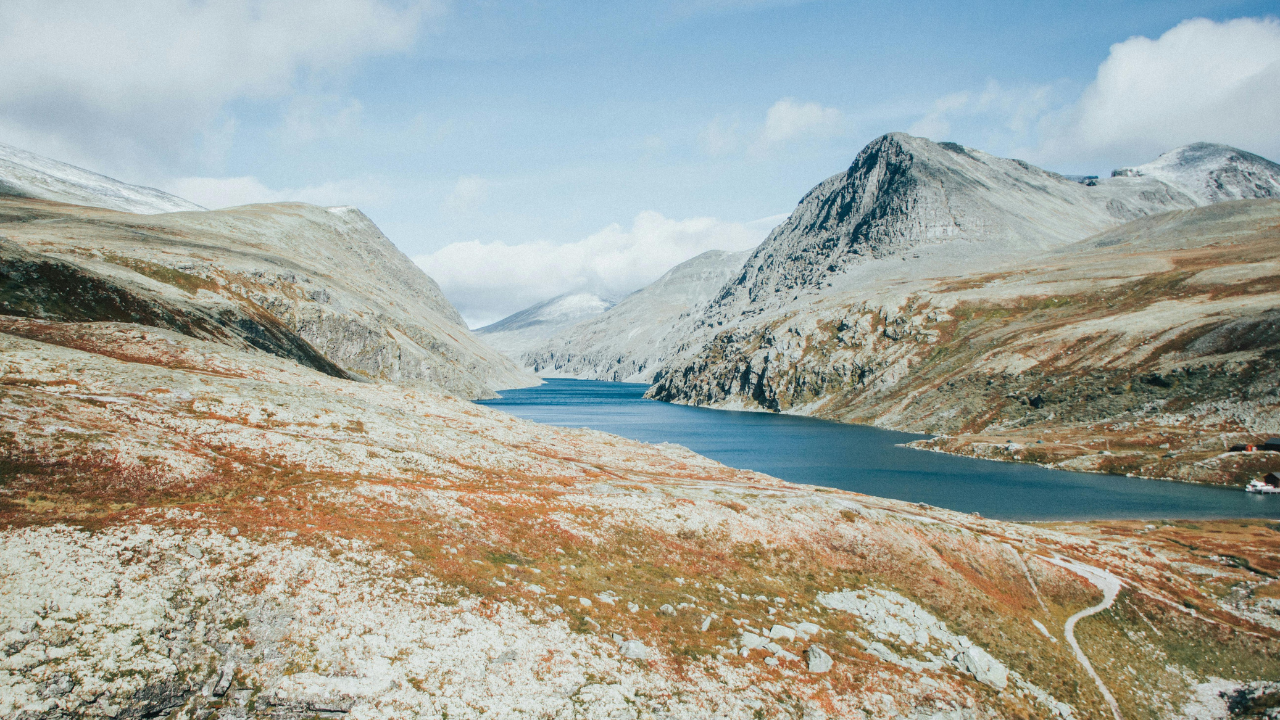
- Size: 963 square kilometers
- Landscape: Rolling mountains, deep valleys, and high plateaus
- Notable Features: Ten peaks above 2,000 meters and important wild reindeer habitat
- Popular Routes: The circuit around the central massif, Rondslottet summit (2,178m)
Rondane’s relatively gentle terrain makes it perfect for hikers who want mountain experiences without extreme technical challenges. Its proximity to populated areas makes it one of the more accessible national parks for day visitors from cities like Oslo.
Hardangervidda National Park: Europe’s Largest Mountain Plateau
Hardangervidda spans an enormous high-altitude plateau that offers a unique hiking environment:

- Size: 3,422 square kilometers (Norway’s largest national park)
- Landscape: Rolling plateau with countless lakes, rivers, and streams
- Wildlife Highlight: Europe’s largest wild reindeer herd
- Cultural Features: Ancient trade routes and hunting sites
The park’s vast open spaces provide a true wilderness experience, with extensive trail networks and well-placed mountain huts. The relatively flat terrain is perfect for those seeking long-distance hiking without steep climbs, though weather can change rapidly across this exposed landscape.
Lofotodden National Park: Where Mountains Meet the Sea
Norway’s newest national park (established 2019), Lofotodden protects the dramatic landscapes of the outer Lofoten archipelago:
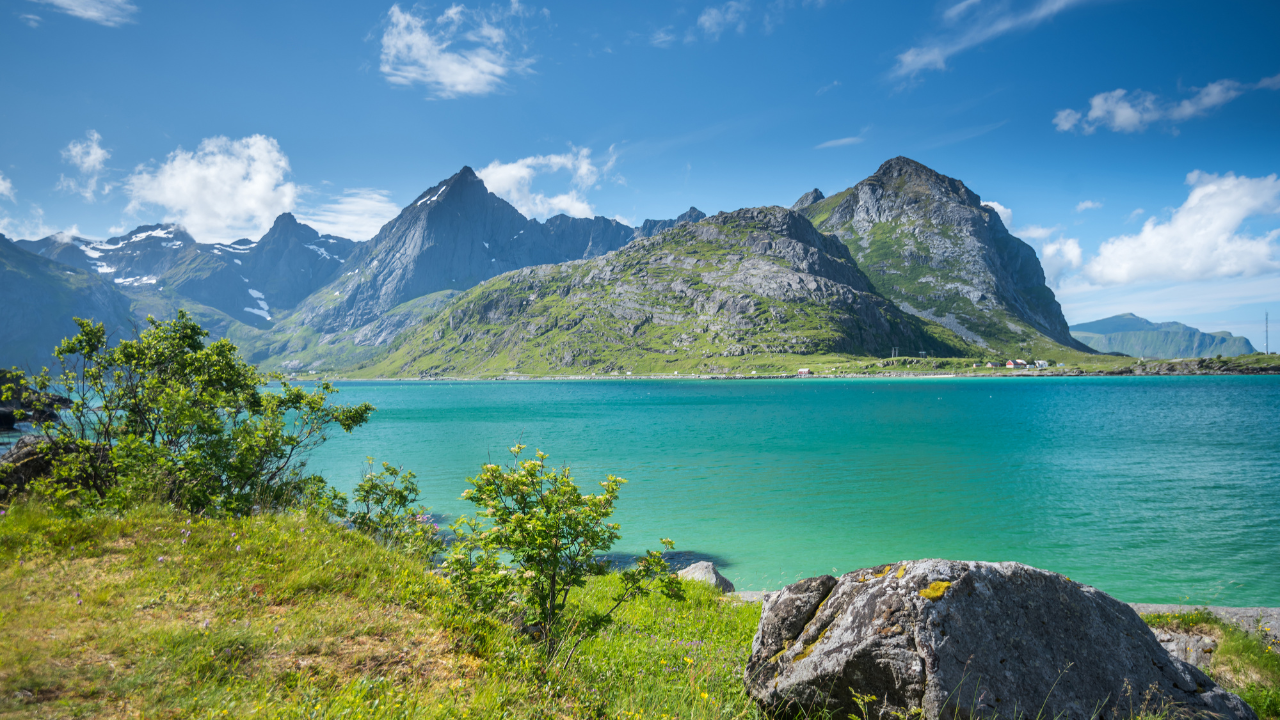
- Location: Western end of the Lofoten Islands in Northern Norway
- Landscape: Jagged mountain peaks rising directly from the sea
- Highlights: Ryten mountain with views of Kvalvika Beach, Munkebu hut trail
- Unique Feature: Combines alpine and coastal environments in one compact area
This park offers some of Norway’s most photographed landscapes, where dramatic peaks create perfect backdrops for hikers seeking both mountain and coastal experiences in a single trip.
Visitor Facilities and Services
Norway’s national parks are well-equipped to welcome visitors while preserving their natural character:
- Visitor Centers: Most major parks have interpretive centers with exhibits, maps, and expert advice
- DNT Cabins: The Norwegian Trekking Association maintains a network of over 550 cabins throughout the country, many within or near national parks
- Marked Trails: Red “T” marks painted on rocks guide hikers on established routes
- Maps and Resources: Detailed topographic maps are available for all parks, along with official websites providing current conditions
- Guided Tours: Local operators offer expert-led experiences for those who prefer additional support
Norway’s “Right to Roam” (Allemannsretten) principle applies in national parks, allowing hikers to camp freely following simple guidelines: stay at least 150 meters from inhabited houses/cabins and follow Leave No Trace principles. This freedom makes Norway’s wilderness areas particularly appealing to self-sufficient adventurers.
Scenic Drives in Norway
While hiking offers intimate encounters with Norway’s landscapes, scenic drives in Norway provide a complementary way to experience the country’s natural beauty. These carefully designed routes connect major attractions and access points for hiking trails, making them an essential part of any comprehensive Norwegian adventure.
The Atlantic Road: Ocean Highway
The Atlantic Road (Atlanterhavsveien) is an engineering marvel that hops across small islands and reefs via a series of bridges:
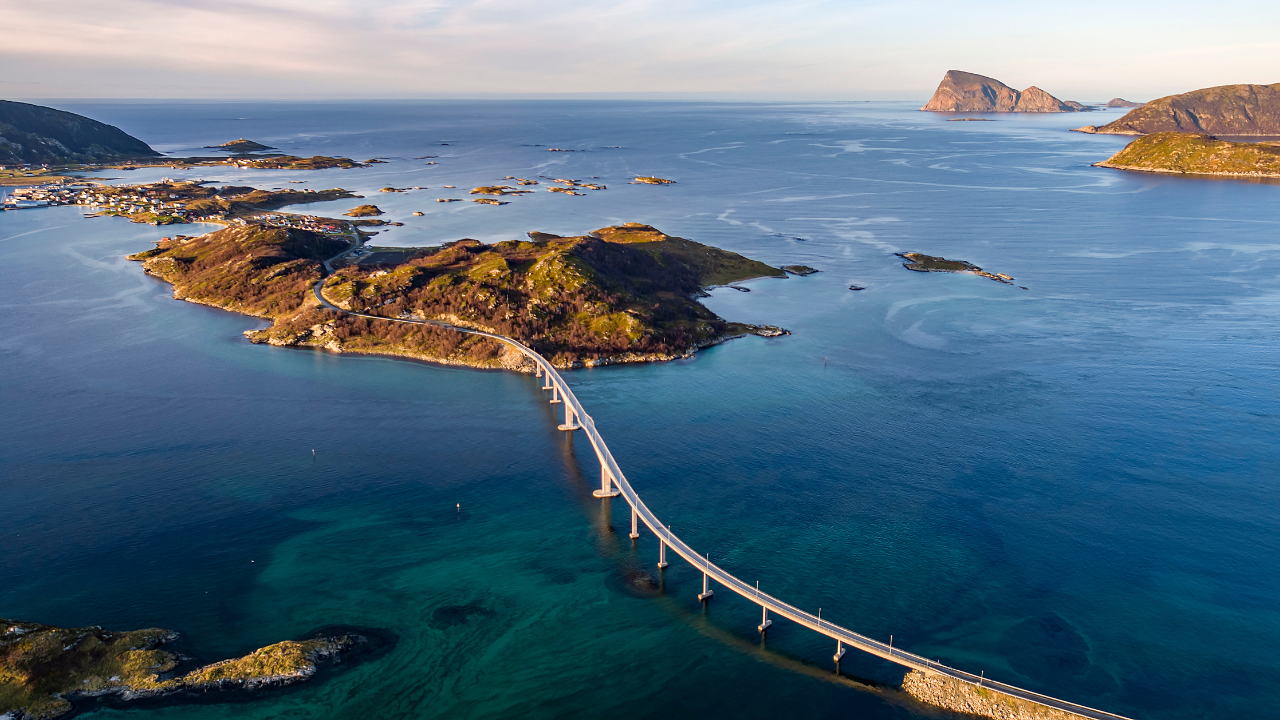
- Length: 8.3 kilometers (part of National Tourist Route)
- Location: Connects the islands between Molde and Kristiansund in western Norway
- Highlight: The curved Storseisundet Bridge, known as “The Bridge to Nowhere”
- Best Experience: During stormy weather when waves crash over the road (from safe viewing points)
This dramatic coastal drive provides access to excellent shoreline hiking paths and bird-watching opportunities. Parking areas with viewing platforms are strategically placed along the route, allowing visitors to safely experience the power of the Norwegian Sea.
Trollstigen: The Troll’s Path
Trollstigen is perhaps Norway’s most famous mountain road, featuring 11 hairpin bends that climb a steep mountainside:

- Location: Between Åndalsnes and Valldal in western Norway
- Elevation Gain: Climbs from sea level to 858 meters
- Viewing Platform: Spectacular cantilevered overlook at the summit
- Hiking Connection: Access point for trails to Bispevatnet lake and surrounding peaks
The visitor center at the top offers information about local hiking trails that lead from the road into the surrounding mountains. Trollstigen is typically open from late May to October, depending on snow conditions.
National Tourist Routes
Norway has designated 18 National Tourist Routes that showcase particularly scenic sections of road with enhanced services for travelers:
- Hardanger National Tourist Route: Winds through Norway’s fruit-growing region alongside Hardangerfjord, connecting to hiking trails in Hardangervidda National Park [SOURCE]
- Lofoten National Tourist Route: Traverses the dramatic Lofoten archipelago, providing access to countless hiking trails with ocean views
- Sognefjellet National Tourist Route: Northern Europe’s highest mountain pass (1,434m), connecting the Sognefjord with Jotunheimen National Park’s trail network
These routes feature architectural rest areas, viewing platforms, and information points designed by renowned architects to enhance the travel experience while blending with the natural environment.
Geiranger-Trollstigen National Tourist Route
This spectacular drive combines two of Norway’s most famous attractions:
- Total Length: 106 kilometers
- Highlights: Geirangerfjord (UNESCO World Heritage site), Eagle Road switchbacks, Trollstigen
- Viewpoints: Ørnesvingen (Eagle Bend), Flydalsjuvet, and Dalsnibba (1,500m)
- Hiking Options: Access to trails overlooking the Seven Sisters waterfall
This route offers some of Norway’s most photographed landscapes and provides access to numerous hiking trails of varying difficulty. The viewpoints along this drive offer perspectives that would be difficult or impossible to achieve on foot.
Practical Tips for Scenic Driving
To make the most of Norway’s scenic routes while incorporating hiking opportunities:
- Seasonal considerations: Many mountain roads (including Trollstigen) are closed in winter due to snow
- Plan strategically: Use scenic drives to connect different hiking regions, maximizing your experience
- Allow extra time: Frequent photo stops and short walks from viewpoints will make your journey longer than expected
- Book accommodation strategically: Stay near trailheads to maximize hiking time
- Consider one-way car rentals: This allows for linear routes rather than backtracking
Norway’s road system is exceptionally well-maintained, with clear signage and regular rest areas. While some routes feature narrow sections and tunnels, they are generally accessible to standard vehicles during the summer season.
By combining scenic drives with hiking adventures, you’ll experience Norway’s landscapes from multiple perspectives – from the intimacy of mountain trails to the sweeping panoramas only possible from carefully designed viewpoints along these engineering marvels.
Embracing Outdoor Adventures in Norway
Norway’s diverse landscapes create the perfect playground for a wide range of outdoor adventures beyond hiking. By combining different activities, visitors can experience the full spectrum of what this remarkable country has to offer, from coastal explorations to mountain challenges.
Multi-Activity Itineraries
Creating varied itineraries allows you to experience Norway’s natural wonders in different ways:
- Morning hikes and afternoon drives: Start early with a hike to beat crowds on popular trails like Preikestolen, then explore scenic routes by car in the afternoon
- Fjord-based adventures: Combine kayaking in the calm morning waters with hikes to viewpoints above the fjords for different perspectives
- Mountain and valley experiences: Tackle challenging alpine terrain one day, then explore gentle valley trails the next for a balanced experience
- Urban and wilderness contrast: Pair city explorations in Bergen or Oslo with nearby natural areas for cultural and natural diversity
This approach prevents fatigue from consecutive days of strenuous hiking while providing a more complete experience of Norway’s diverse landscapes.
Water-Based Activities
Norway’s extensive coastline and inland waterways offer excellent opportunities for water adventures that complement hiking:
- Fjord kayaking: Paddle beneath towering cliffs and waterfalls for a unique perspective
- Wild swimming: Mountain lakes provide refreshing (though chilly!) swimming opportunities after a warm hike
- Fishing: Norway’s rivers and lakes are teeming with fish, offering relaxation after active days
- RIB boat tours: High-speed rigid inflatable boat tours provide thrilling access to coastal features not visible from land
Seasonal Outdoor Adventures
Norway transforms dramatically with the seasons, offering unique experiences throughout the year. To help you plan the perfect timing for your outdoor adventures, explore our detailed guide to the best time to visit Norway:
Summer (June-August)
- Midnight sun hikes: In northern Norway, hike under the midnight sun for a magical experience
- Alpine flowers: Midsummer brings colorful wildflower displays in mountain meadows
- Swimming: Brave souls can enjoy refreshing dips in mountain lakes and fjords
Autumn (September-October)
- Fall colors: Birch forests turn golden, creating spectacular landscapes
- Berry picking: Forage for wild blueberries, cloudberries, and lingonberries during hikes
- Fewer crowds: Popular trails become more peaceful after the summer peak
Spring (May-June)
- Waterfall spectacles: Melting snow creates powerful waterfall displays
- Bird watching: Spring migration brings abundant birdlife to coastal areas
- Blooming fruit orchards: Particularly beautiful in the Hardanger region
While winter (November-April) sees most highland hiking trails closed due to snow, it offers its own adventures including cross-country skiing, snowshoeing, and northern lights viewing that can be incorporated into a cold-season visit.
Cultural Dimensions of Outdoor Adventures
Norway’s natural landscapes are deeply intertwined with its cultural heritage:
- Historical routes: Many hiking trails follow ancient travel and trade routes used for centuries
- Folklore connections: Natural features like Trolltunga are associated with rich Norwegian myths and legends
- Farm visits: Traditional mountain farms (seter) sometimes offer refreshments to passing hikers
- Local cuisine: Refuel after adventures with traditional Norwegian foods like brown cheese (brunost) or wild game
Learning about these cultural dimensions adds depth to physical adventures, connecting visitors to Norway’s human history alongside its natural wonders. Many mountain lodges serve traditional foods and display historical information about their regions.
Frequently Asked Questions about Hiking in Norway
When is the best time to hike in Norway?
The most favorable periods for hiking in Norway are during the shoulder and late summer seasons—from late June through September. During this time, snow is usually melted from most mountain trails, and the weather is milder. For autumn colors, fewer crowds, and pleasant temperatures, September is especially ideal. While May and early June can offer dramatic waterfalls and spring scenery, trail accessibility may still be variable.
What essential safety considerations should hikers in Norway know?
Safety in Norwegian hiking relies on following the Mountain Code: plan your route, adapt to conditions, check weather and avalanche warnings, carry proper gear (map, compass, waterproof clothing), and don’t hesitate to turn back if conditions worsen. Be aware that weather changes rapidly in the mountains, and always inform someone of your plans before heading into remote areas.
What key items should I pack for a hiking trip in Norway?
Packing smart means using a layering system: a moisture-wicking base layer (avoid cotton), insulating mid layer (e.g., fleece), and a waterproof and windproof outer shell. Also include waterproof hiking boots, wool socks, extra warm clothing, rainwear (jacket and trousers), hat, and gloves. Don’t forget navigation tools and emergency supplies for mountain conditions.
How can travelers combine hiking with scenic drives in Norway?
Many visitors augment hiking with Norway’s dramatic National Tourist Routes—like Trollstigen, the Atlantic Road, or the Hardanger and Lofoten routes—each offering access to trailheads, panoramic walks, and stunning photo stops. Plan drives and hikes to complement each other, allowing time for viewpoints, short strolls, and local accommodations near key trailheads.
Is camping freely allowed during hikes in Norway?
Yes—thanks to Norway’s “Right to Roam” (allemannsretten), visitors may camp almost anywhere in uncultivated areas, provided they stay at least 150 meters from inhabited buildings and respect the environment. This freedom, combined with marked trails and mountain huts, makes Norway ideal for self-sufficient wilderness hiking.

